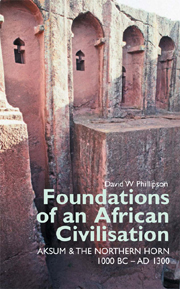Book contents
- Frontmatter
- Contents
- List of illustrations
- 1 General introduction
- Part One BEFORE AKSUM
- Part Two THE KINGDOM OF AKSUM
- 4 Aksumite civilisation: an introductory summary
- 5 Aksumite languages and literacy
- 6 Some written sources relating to Aksumite civilisation
- 7 The emergence and expansion of the Aksumite state
- 8 Aksumite kingship and politics
- 9 Aksumite religion
- 10 Cultivation and herding, food and drink
- 11 Urbanism, architecture and non-funerary monuments
- 12 Aksumite burials
- 13 Aksumite technology and material culture
- 14 Aksumite coinage
- 15 Foreign contacts of the Aksumite state
- 16 Decline and transformation of the Aksumite state
- Part Three AFTER AKSUM
- Bibliographic references
- Index
- EASTERN AFRICAN STUDIES
14 - Aksumite coinage
from Part Two - THE KINGDOM OF AKSUM
Published online by Cambridge University Press: 05 December 2015
- Frontmatter
- Contents
- List of illustrations
- 1 General introduction
- Part One BEFORE AKSUM
- Part Two THE KINGDOM OF AKSUM
- 4 Aksumite civilisation: an introductory summary
- 5 Aksumite languages and literacy
- 6 Some written sources relating to Aksumite civilisation
- 7 The emergence and expansion of the Aksumite state
- 8 Aksumite kingship and politics
- 9 Aksumite religion
- 10 Cultivation and herding, food and drink
- 11 Urbanism, architecture and non-funerary monuments
- 12 Aksumite burials
- 13 Aksumite technology and material culture
- 14 Aksumite coinage
- 15 Foreign contacts of the Aksumite state
- 16 Decline and transformation of the Aksumite state
- Part Three AFTER AKSUM
- Bibliographic references
- Index
- EASTERN AFRICAN STUDIES
Summary
Study of Aksumite coinage has proved highly informative both to numismatists and to historians more generally. Although its issue did not begin until the late-third century AD, it is important to recognise that small quantities of coins were already reaching northern Ethiopia from elsewhere during earlier periods, including examples struck in the Roman Empire, southern Arabia, and the Kushan kingdom in the region now comprising northeastern Afghanistan, northern Pakistan and parts of northwestern India. With the exception of very occasional specimens from excavated contexts in the Aksum area, most examples of southern Arabian coins – including one hoard – are chance finds. Despite ancient documentary evidence that small quantities of Roman coinage were imported to Adulis, apparently around the mid-first century AD, for use by the foreign merchants there, it seems that no such specimens have yet been recorded from archaeological excavations other than those from contexts of significantly later date. A hoard of gold objects from Matara (Chapter 13) included fourteen second-century Roman gold coins, all but one with suspension-loops indicating their eventual use as jewellery, but the excavators considered that the hoard was deposited in the sixth century and the date when the coins were imported cannot be ascertained. Even more intriguing is a hoard of 105 gold Kushan coins recorded as having been found c. 1940 in an ancient wooden box buried in a cavity of the cliff beneath the Debra Damo monastery in northernmost Tigray.
- Type
- Chapter
- Information
- Foundations of an African CivilisationAksum and the northern Horn, 1000 BC - AD 1300, pp. 181 - 194Publisher: Boydell & BrewerPrint publication year: 2012



